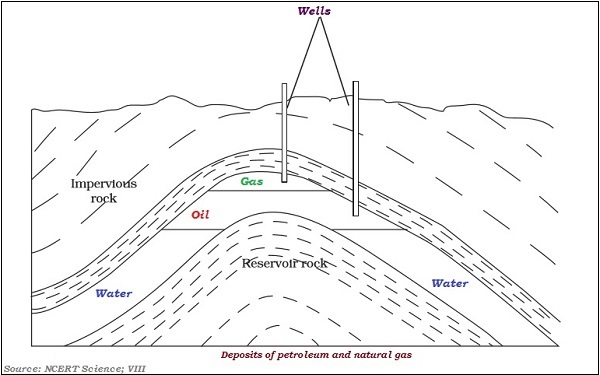Introduction
- The resources, which are present in unlimited quantity in nature and are not likely to be exhausted by human activities, are known as Inexhaustible Natural Resources. E.g. sunlight, air.
- The resources, which are present in limited quantity in nature and are likely to be exhausted by human activities, are known as Exhaustible Natural Resources. E.g. forests, wildlife, minerals, coal, petroleum, natural gas etc.
- Exhaustible natural resources were formed from the dead remains of living organisms (fossils); therefore, these natural resources are also known as fossil fuels. E.g. coal, petroleum and natural gas.
Coal
- Coal is hard as stone and black in color.
- Coal is one of the fuels used to cook food.

- Coal is used in thermal power plants to produce electricity.
- Under high pressure and high temperature, the dead plants those got buried inside the Earth, got slowly converted into coal.
- Coal contains mainly carbon.
- The slow process of conversion of dead vegetation into coal is known as carbonization.
- Coal is formed from the remains of vegetation; therefore, it is also known as fossil fuel.
- When coal burns, it produces mainly carbon dioxide gas.
- When coal is processed in industry, it produces some useful products such as coke, coal tar, and coal gas.
- Coke is a hard, porous, and black substance.
- Coke is pure form of carbon.
- Coke is largely used in the manufacturing of steel and in the extraction of many metals.
- Coal tar is a black, thick liquid with unpleasant smell.
- Coal tar is mixture of about 200 substances.
- The products, those are obtained from coal tar, are used as starting materials for manufacturing various substances used in everyday life and in industry. E.g. explosives, paints, roofing materials, synthetic dyes, drugs, perfumes, plastics, photographic materials, etc.
- Naphthalene balls, obtained from coal tar, are used to repel moths and other insects.
- Bitumen, obtained from petroleum product, is used in place of coal-tar for metalling the roads.
- During the processing of coal to get coke, coal gas is obtained.
- In 1810, for the first time in London, UK, coal gas was used for street lighting and in 1820, in New York, USA.
- At present, coal gas is used as a source of heat.
Petroleum
- Petrol and diesel are obtained from a natural resource known as petroleum.
- Petroleum was formed from the organisms living in the sea.
- Over millions of years (the dead organisms buried inside the earth), in the presence high temperature, high pressure, and in the absence of air, the dead organisms transformed into petroleum and natural gas.
- In 1859, the world’s first oil well was drilled in Pennsylvania, USA.
- In 1867, oil was stuck at Makum in Assam, India.
- In India, petroleum is largely found in Assam, Gujarat, Mumbai High, Maharashtra, and in the river basins of Godavari and Krishna.
- The following image illustrates the layer of gas and oil −

- Petroleum is a mixture of various constituents such as petrol, petroleum gas, diesel, lubricating oil, paraffin wax, etc.
- The process of separating the various constituents of petroleum is known as refining.
- The different useful substances, which are obtained from the petroleum and natural gas, are known as ‘Petrochemicals.’
- Petrochemicals are used in the manufacturing of detergents, fibers (polyester, nylon, acrylic etc.), polythene and other man-made plastics.
- Hydrogen gas, which is obtained from natural gas, is used in the production of fertilizers (urea).
- Because of having the great commercial importance, petroleum is also known as ‘black gold.’
- Natural gas is normally stored under high pressure and hence known as Compressed Natural Gas (CNG).
- CNG is used for power generation and fuel for vehicles.
- The following table illustrates various constituents of petroleum and their uses −
| Constituents of petroleum | Uses |
|---|---|
| Petroleum Gas in Liquid form (LPG) | Fuel for home and industry |
| Petrol | Motor fuel, aviation fuel, solvent for dry cleaning |
| Diesel | Fuel for heavy motor vehicles, electric generators |
| Kerosene | Fuel for stoves, lamps and for jet aircrafts |
| Lubricating oil | Lubrication |
| Paraffin wax | Ointments, candles, Vaseline, etc. |
| Bitumen | Paints, road surfacing |


